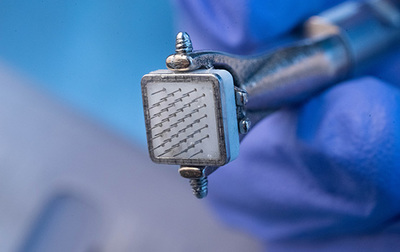Cortical vision device could restore sight to the blind

Monash University researchers have developed a cortical vision device that could one day help restore sight to the blind, thanks to the use of miniaturised, wireless electronic implants that sit on the surface of the brain.
Many people who are clinically blind have damaged optic nerves, preventing signals from being transmitted from the retina to the ‘vision centre’ of the brain. The Gennaris bionic vision system — the brainchild of the Monash Vision Group (MVG) — is designed to bypass this damage, making it possible to treat many conditions that currently have treatment limitations.
The system comprises custom-designed headgear with a camera and wireless transmitter, a vision processor unit and software, and a set of 9 x 9 mm tiles that are implanted into the brain. The scene captured by the video camera in the headgear will be sent to the vision processor — similar in size to a smartphone — where it will be processed to extract the most useful information. The processed data will be transmitted wirelessly to complex circuitry within each implanted tile; this will convert the data into a pattern of electrical pulses, which will stimulate the brain via hair-thin microelectrodes.
“Cortical vision prostheses aim to restore visual perception to those who have lost vision by delivering electrical stimulation to the visual cortex — the region of the brain that receives, integrates and processes visual information,” said MVG Director Professor Arthur Lowery, who is also principal investigator of the Cortical Frontiers project.
“Our design creates a visual pattern from combinations of up to 172 spots of light (phosphenes) which provides information for the individual to navigate indoor and outdoor environments, and recognise the presence of people and objects around them,” he added. Further investigations have shown promise for this technology to deliver improved health outcomes to patients with neurological conditions such as limb paralysis.

The implant was recently trialled on sheep, in one of the first long-term tests of a fully implantable cortical vision prosthesis in the world — with the results published in the Journal of Neural Engineering. In preclinical studies, 10 arrays (seven active and three passive) were implanted using a purpose-built insertion system; stimulation was delivered through the seven active devices for up to nine months. Cumulatively, more than 2700 hours of stimulation was performed without any observable adverse health effects.
“The study results indicate that long-term stimulation through wireless arrays can be achieved without induction of widespread tissue damage, nor visible behavioural issues or seizures resulting from the stimulation,” said Professor Jeffrey Rosenfeld, lead author of the study.
In June 2019, it was announced that the Cortical Frontiers project would receive more than $1 million under the Australian Government’s Medical Research Future Fund (MRFF) Frontier Health and Medical Research program to advance the technology and put forward a detailed plan for future investment. The announcement of the second stage of MRFF funding, due to occur later this year, will support the best one or two applications with millions of dollars in funding across the next five years.
“If successful, the MVG team will look to create a new commercial enterprise focused on providing vision to people with untreatable blindness and movement to the arms of people paralysed by quadriplegia, transforming their health care,” said Dr Philip Lewis from the Monash Department of Electrical and Computer Systems Engineering.
Dr Yan Wong, from the Monash Biomedicine Discovery Institute (Monash BDI), added, “The commercialisation of the bionic vision technology also ties in nicely to our plans for exploring further applications beyond vision and spinal cord injury, such as the moderation of epilepsy and depression, brain-controlled prosthetics, and the restoration of other vital senses.”
With additional funding, it is hoped that the technology will be produced in Melbourne for distribution globally. Monash BDI’s Professor Marcello Rosa said commercial success could see the creation of new export opportunities, highly skilled manufacturing and medical device design jobs, and economic growth for Australia.
“With extra investment, we’ll be able to manufacture these cortical implants here in Australia at the scale needed to progress to human trials,” Prof Rosa said.
Please follow us and share on Twitter and Facebook. You can also subscribe for FREE to our weekly newsletters and bimonthly magazine.
Originally published here.
The voice of reason: natural language interfaces to transform lab informatics
In everyday life, voice interaction with technology can save time and reduce friction. The same...
COVID vax linked to smaller risk of heart problems than infection
The risk of rare heart complications following COVID-19 vaccination in children was found to be...
Ancient lead exposure shaped human evolution
An international study claims that exposure to lead may have influenced the evolution of hominid...







